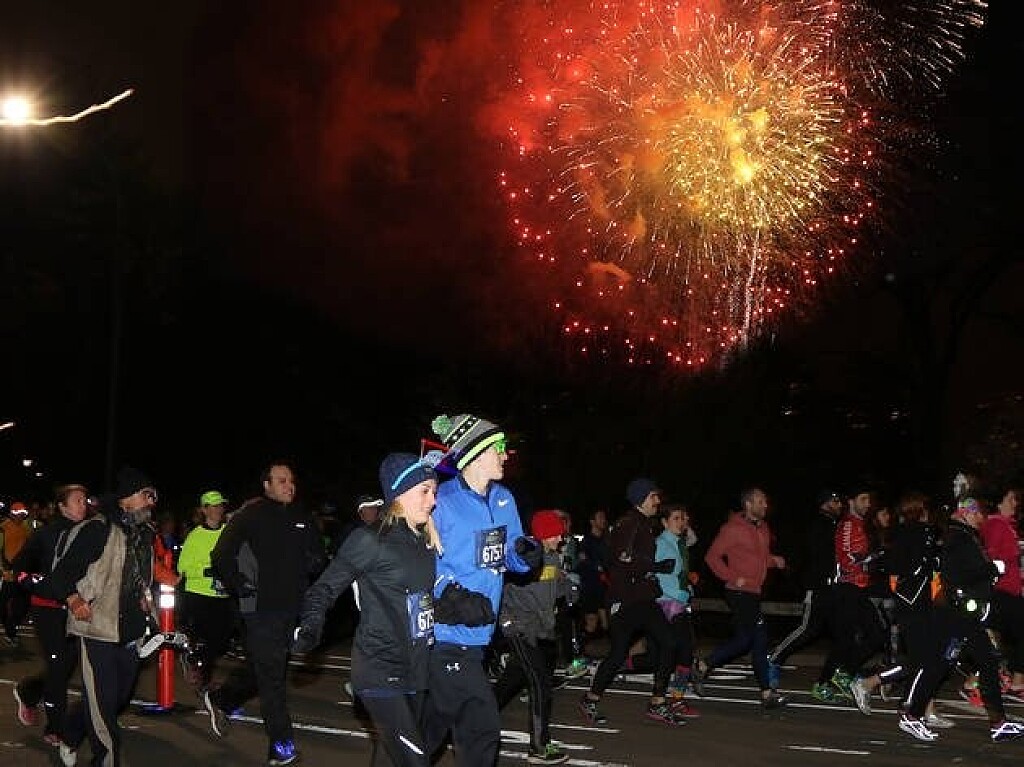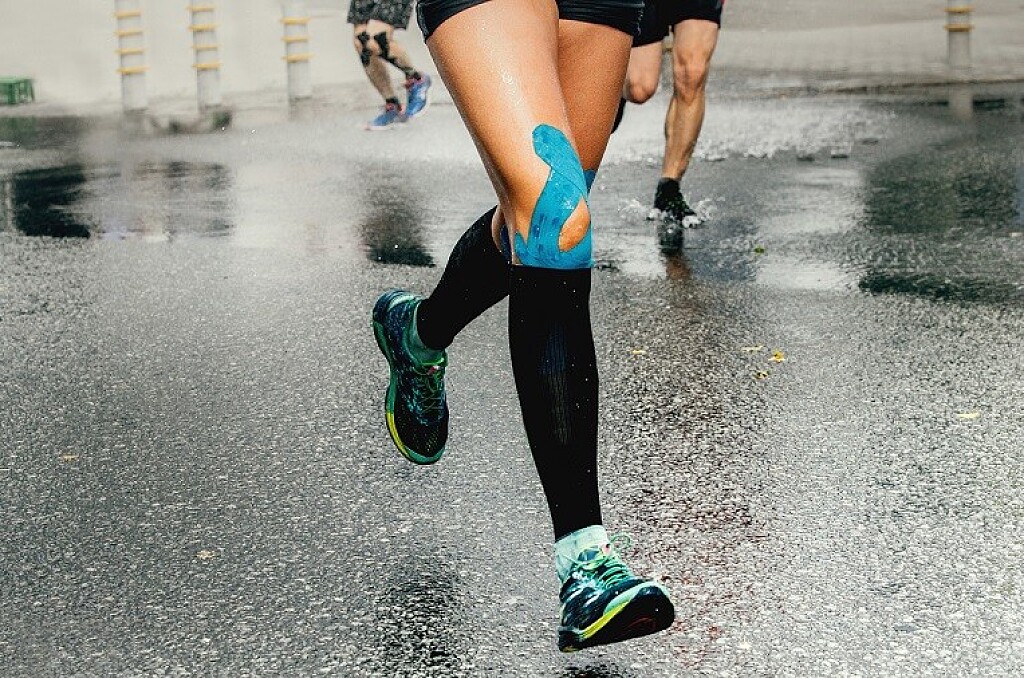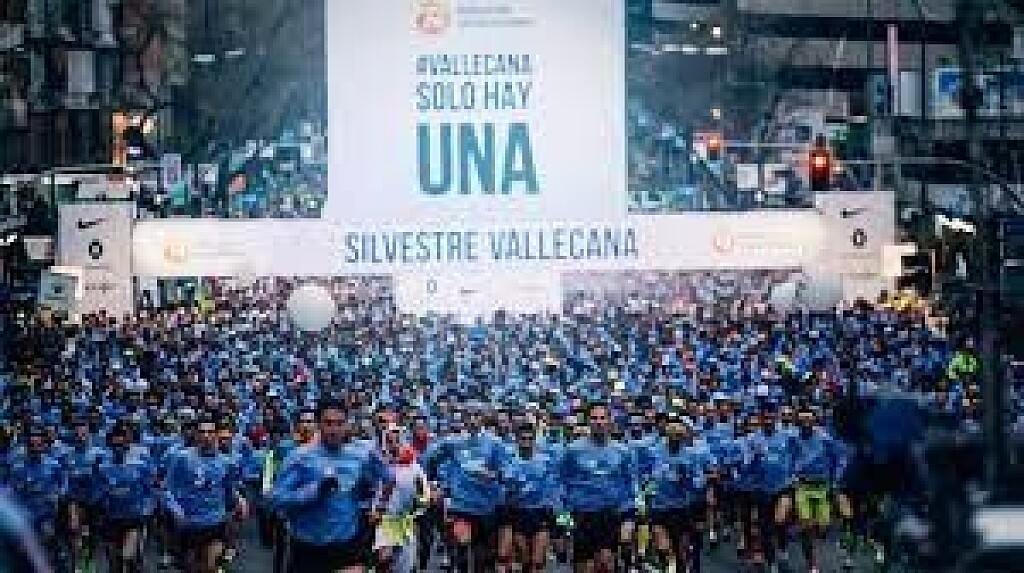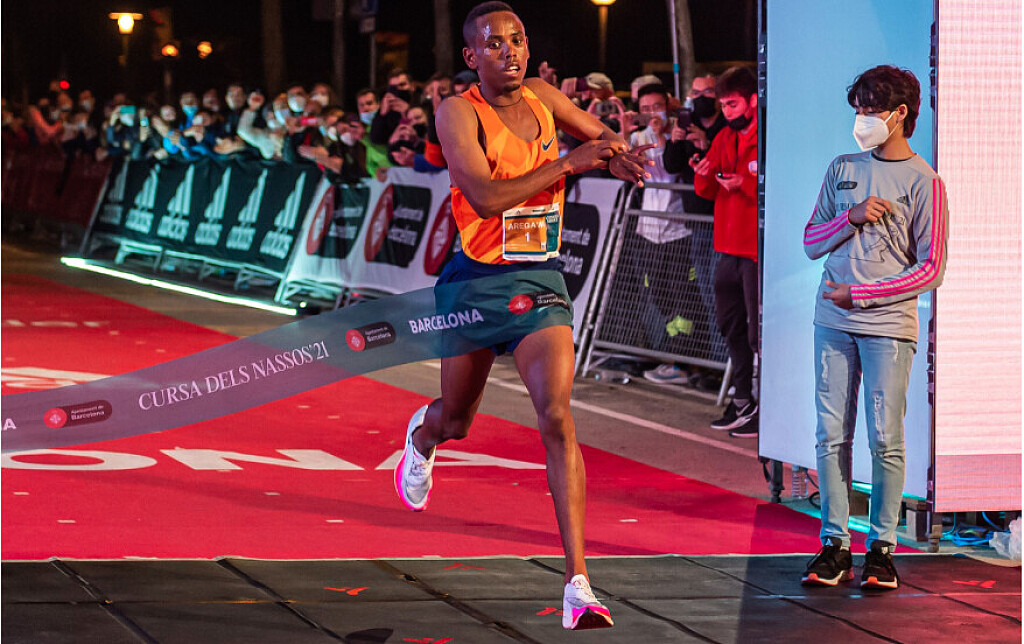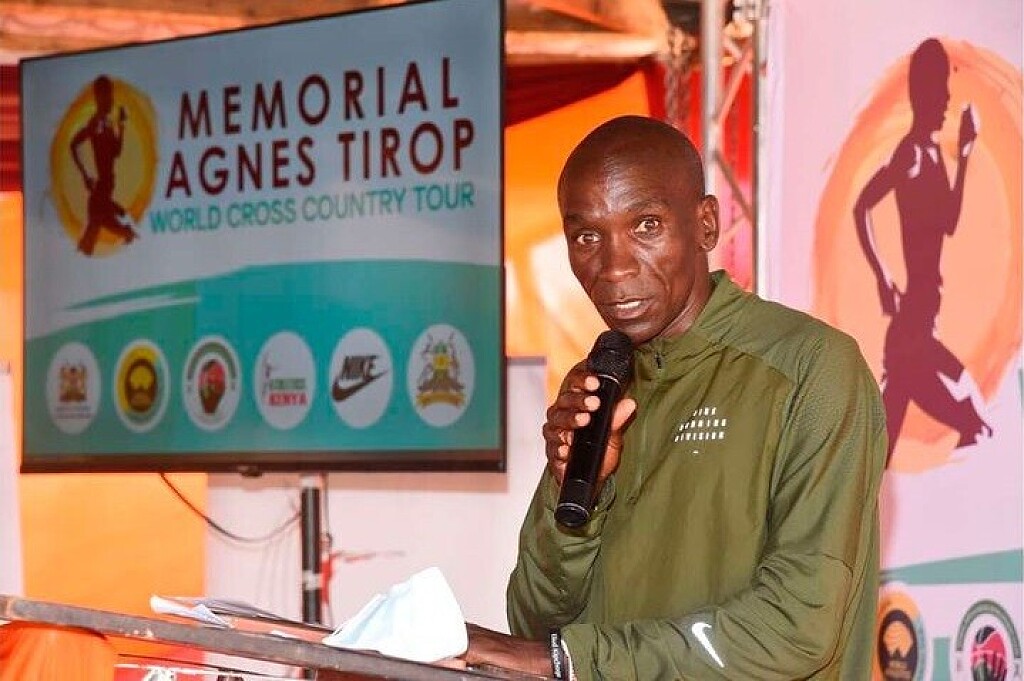Running News Daily
Top Ten Stories of the Week
1/8/2022
These are the top ten stories based on views over the last week.
New Year's resolutions for runners and how to keep them
Create a consistent running plan.
Consistency is key to improving fitness and sticking with something. While sure, you’ll experience some fitness gains from running haphazardly, lasting and life-changing benefits come about after developing a healthy habit.
Train with a group.
We’re stronger together. As a brand dedicated to growing community, we understand first-hand the importance of finding your tribe. And when it comes to training, turns out there’s science to back it. According to a recent study, when you work out with a group, your levels of emotional, mental, and physical stress are much lower than they would be if you worked out alone.
Incorporate strength work into your weekly training.

Running is a repetitive forward motion. Without incorporating a balanced strength-training plan, it’s easy to experience muscular imbalance and injury. But weight training doesn’t mean throwing around heavy weights in the gym, a group fitness class might be exactly what you need. Check with your Fleet Feet to see if they host any weekly classes in the store.
Start a meditation practice.
We promise we’re not getting woo-woo on you. But seriously, meditation will make you a better runner (and a better person, too). That's because meditation helps you to de-stress, cultivate compassion, and feel calmer and more in tune with the present moment. When it comes to running, meditation also helps you manage pain. Meditate your way to a new PR? Maybe so!
Set at least two race goals.

Like we said in this post, if you want to accomplish your goals, you need to set specific, measurable, attainable, realistic, and time-focused goals. We recommend setting a PR goal in a race distance you’ve already completed and then setting a new distance goal for later in the year. Perhaps you’re shooting to break your 5K PR in the spring and then working to complete a half marathon in the fall.
Stretch every day.
We’ve written about the balance of strength to flexibility before. But we’ll say it again and again because it’s that important. Incorporating a few key stretches after every workout will help keep to keep you injury free. Check out this post for some runner-specific yoga poses.
Perform self-massage after every hard run.
Massage feels good and helps us recover faster by improving circulation, decreasing inflammation, and reducing muscle tightness.
Create or participate in a fun weekly group run to spice things up.
Like we learned in number two, it’s beneficial to our health to run with other people. Take that one step further and incorporate social runs like a weekly pub run, run n’ brunch, or run + coffee. This will keep training fresh and interesting, so you’re more likely to stick to it.
(12/31/21) Views: 163Bob Cooper
Does KT tape really work?
Over the last decade, Kinesio tape has become popular among athletes and sports rehab specialists to help alleviate the pain from some injuries. Over that time, several studies have been done to assess the tape’s efficacy, with inconclusive results.
A recent study took another stab at the topic, and determined the tape is more than just a placebo — as long as you use the appropriate amount of tension.
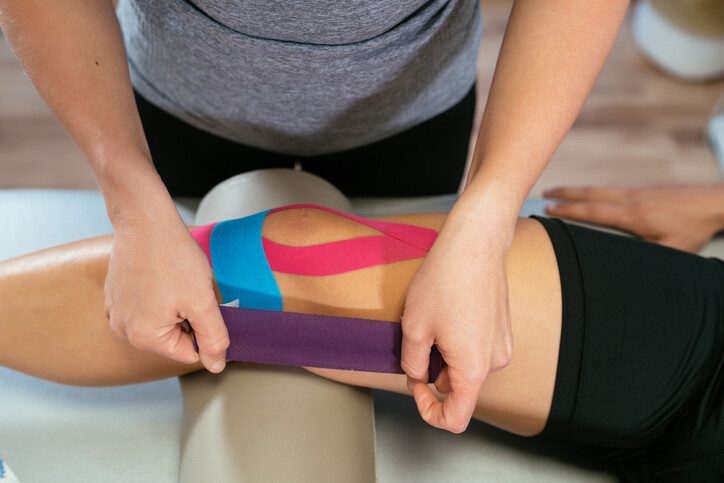
Light tension works the best
The goal of the study, which was published in the journal Plos One, was to address the gaps in the current KT and pain literature, to ascertain if the pain-relieving effect is simply a placebo effect and to experiment whether KT applied at different tensions reduces pain.
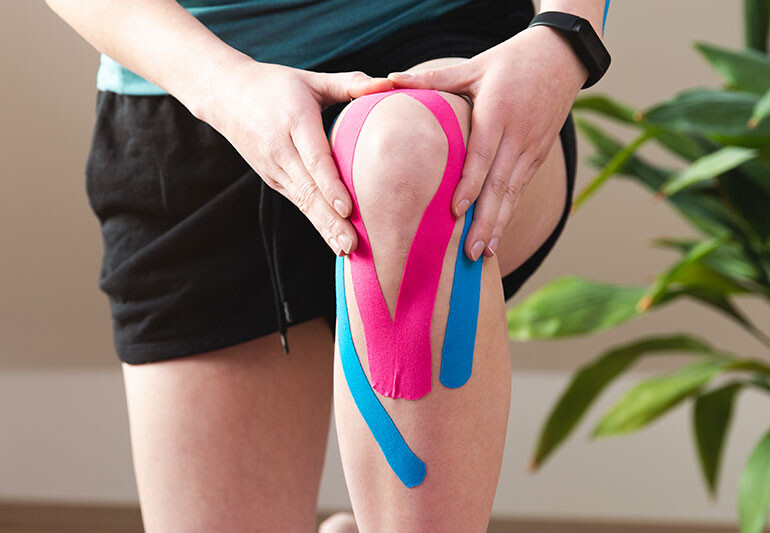
To do this, the researchers tested KT tape at no tension, light tension (25 per cent of max tension) and high tension (75 per cent of max tension). Their results indicated that the light tension wrap was the most effective at reducing pain, while the high tension produced no pain-relieving effects. “In conclusion, the current study suggests that KT applied at low tension provides a greater pain relieving effect compared to no tape and KT applied at no tension and high tension for pressure-evoked muscle pain,” the researchers wrote.
They added their results indicate that the efficacy of KT tape is likely more than a placebo effect, but more research needs to be done to understand how KT tape actually relieves pain and to determine if patient expectations contribute to KT’s pain-relieving effect.
The bottom line
If you use KT tape and you find it helps, keep using it, but be mindful of how much tension you’re using when applying it. If you want to get the maximum benefit from the tape, it’s important that you apply it properly, so ask a physiotherapist or other sports practitioner for help if you’re unsure
(01/03/22) Views: 89Brittany Hambleton
7 Things That Happened When I Ate Beets for Two Weeks
The wondrous root vegetable is supposed to be a godsend for endurance athletes
Beets are all the rage right now, especially for runners. As I started dipping my toe back into marathon training, I wanted to find out why. Is this miracle vegetable really going to make my running that much better?

The research in recent years is convincing. The basic premise is that beets are an excellent source of nitrate, which is shown to decrease blood pressure. Essentially, what a 2013 study by Andy Jones, a professor of applied physiology at the University of Exeter and go-to expert on beets and performance, showed is that the amount of oxygen you need to sustain exercise decreased after consuming beet juice. In other words, it took less energy to run the same pace.
According to the research, which was performed with cyclists, the athletes were tested about 2.5 hours after ingesting beet juice. The highest dose of juice (four doses), which was in concentrated 70 mL shots, produced the best results—a 3 percent decrease in oxygen consumption.
In an interview with Asker Jeukendrup, a sport nutrition scientist who writes at MySportScience.com, Jones said the evidence is strong that beets have an effect on sport performance.
“I don’t think there’s much doubt that nitrate has physiological effects,” he said. “The evidence for dietary nitrate reducing resting blood pressure, and therefore potentially impacting positively on cardiovascular health, is really robust. The key now is to find out in which populations and sporting events it may be most effective in improving performance.”
A newer study in 2016, led by Lex Verdijk at the Maastricht University in the Netherlands, was conducted on soccer players. The players who drank two concentrated beet shots per day, on average, covered a 3.4 percent greater distance in a series of sprints at progressively faster paces. Their heart rate was also lower than those taking placebo.
Race results aside, we know that beets are good for us. If they make running a little bit easier, all the better. And besides, it’s a well-known fact that Eliud Kipchoge, the Olympic gold medalist and owner of the 2:00:25 marathon from the Breaking 2 experiment, is a beet believer. If it’s good enough for him, I’m willing to give the red root vegetables a try.
Here’s what I experienced during 14 consecutive days of beet consumption.

Yes, bathroom visits can be alarming to the uninitiated beet consumer. I already knew that urine and bowel movements would turn a shade of red that might otherwise have caused me to rush to the emergency room. The pigment, called betanin, turns urine and feces an unusual hue for most people and it can last 48 hours depending on how many beets are consumed. Interestingly though, I discovered that it wasn’t always the case for me. It just depended on how I prepared the beets and how much I ate. A big bowl of beet soup had a bigger, uh, impact, than a bowl of chopped beets with greens. Either way, there’s no cause for panic. Bonus: You’re still getting all the fabulous nutrients like Vitamin C, folate, and potassium.
I felt full, though sometimes bloated. Beets are filling. One cup, which is what I used as one serving, contains 3.8 grams of fiber (about 14 percent of the recommended daily allowance), according the USDA. Most days I combined that serving with other vegetables or fruits, in a smoothie, for example, which kept me satiated far longer than my normal meals. That was a bonus, though to be honest some days it felt like too much. I was bloated and that was uncomfortable, especially while running. The bloat went away after the first few days, though the fullness factor remained, which meant I didn’t do my usual constant grazing throughout the day like I typically do. One smoothie in the morning was enough to power me through until lunch. My recipe of choice was the “Can’t Beet Me” smoothie from Run Fast, Eat Slow , which includes blueberries, coconut water, almond milk, a banana, and almond butter (I also used it as a post-long run recovery drink).
Powdered beet drink mix made me gag. I had access to a variety of different beet products marketed to athletes, so I gave them a whirl. One day when I was pressed for time, I tried a powdered version that was supposed to be mixed with water and consumed 30 to 60 minutes prior to exercise. It wasn’t good. It almost made me vomit, in fact. So, that was the last time I tried a mix. It tasted kind of like chemical beet-flavored cough syrup.
Then I tried a liquid “beet performance supplement,” which is like a shot of beet juice the equivalent of three beets. As advertised, it’s supposed to improve “stamina, oxygen intake, and cardiovascular health,” and should be consumed about an hour before activity. This had a much better taste and went down easier. Was it the jet fuel it promised to be? I would like to think it was, but it’s hard to say for sure, and most of my runs at this early stage in my training felt challenging no matter what. At $5 per 2 ounces, I probably wouldn’t make it a habit either way. In a pinch, however, the shots were a great way to get a serving of beets checked off the to-do list and tasted just fine.
Preparing beets is easier than I had thought. I’m fairly adept in the kitchen, but I had never tackled beets mostly because they looked like a pain in the rear. I was proven wrong. The easiest way to work beets into your diet is to roast a bunch of them at the beginning of the week and then put them in the fridge. All you have to do is preheat the oven to 375°F, cut off the greens, wrap in aluminum foil, put them on a baking sheet, and let them roast for 60 minutes.
Okay, so peeling them is slightly annoying and your hands definitely turn bright red, but it’s easily washed off, and you only have to go through this chore once a week. Chop the beets as needed for the next five days. I found that when I had them already prepared, I could just throw them on a salad or mix with balsamic and sprinkle with goat cheese whenever I needed another serving.
Forcing beets upon myself upped my overall nutrition game. Although well-meaning friends sent me recipes for a dessert or two that used beets as an ingredient (red velvet brownies, anyone?!), I didn’t try them. Coming off a couple months of an unusually low activity level, I’ve been making a conscious effort to limit the sweets and get my fitness back. What I noticed, however, is that the challenge of incorporating beets into my meals increased the overall nutritional value of meal planning.
My favorite source of dinner recipes came from my good friend Christina Bauer’s blog called Feeding the Frenzy. She happens to be married to ultrarunner extraordinaire Rob Krar and they are vegetarians—and Bauer is an incredible cook. For my final dinner of the two-week challenge, I made her beet borscht, which is packed with vegetables. Top it with a little sour cream, pair it with some crusty bread, and it’s filling enough to be a meal all on its own.
I got creative. A beet cocktail? Don’t mind if I do. Just because I skipped the brownies doesn’t mean I didn’t indulge—beets are fun like that. Case in point: I’m a big believer in Friday happy hour. At the end of my first week of beet consumption, I found myself on an impromptu girls’ night out with two of my BFFs. I realized that I needed to eat some beets to finish off the day.
It was then that “the Beeting” came into my life, which is a cocktail offered at the McMillan, a downtown Flagstaff joint. (Side note: It’s fun to tell your server, “I’ll take a Beeting.”) This adult beverage combines a roasted beet puree, gin, St. Germain, ginger syrup, and fresh lemon muddled with cucumber and basil. It’s beautiful. Did it count as a full serving of beets? I guess that depends on how many you order (I limited myself to one—there was a long run to contend with in the morning, and besides, I doubt this is how Kipchoge consumes his beets).
The first two weeks of marathon training went better than I'd imagined. After a prolonged period away from running due to work deadlines, travel, and other assorted life circumstances, I was understandably worried about how I’d feel ramping up mileage and intensity in my training. While workouts are still a struggle, I can get those long runs done without too much pain. Are the beets the reason why? I doubt they are the sole reason, but they certainly don’t hurt. After a year of catching every flu and cold going around, I’ve remained healthy for a month and I can’t help but think my cleaner diet—anchored by beets—is to thank.
(01/01/22) Views: 88Runner’s World
Most popular running songs and artists of 2021
Are you curious what songs keep our feet moving and heart rate up while we run? Spotify has released the most popular songs and artists featured in public running playlists this year
The data was collected from 964 playlists on Spotify that include the word ‘running’ in either the playlist title or description

Top five songs
1) Blinding Lights – The Weeknd
Although this song was released in late-2019, it has continued to soar at the top of running playlists. Its slow start matches your pace at the beginning of your run, and by the time the beat drops and the synthesizer kicks in, you are running to the beat. It is no surprise to us to see this song as number one.
2) Head & Heart – Joel Corry & MNEK
This 2020 British dance hall hit has an upbeat piano chord similar to Blinding Lights to keep your legs moving forward at a steady pace.
3) Roses – SAINt JHN (Imanbek Remix)
4) The Business – Tiësto
The lyrics say it all, “Let’s get down, let’s get down to business.” The song is about working hard and getting things done. It makes sense why the song is featured on hundreds of running playlists
5) Your Love – ATB & Topic
This is the only song from 2021 in the top five. This song is a remake of the 1998 hit – 9 PM by ATB. The song maintains 126 beats per minute, which is a perfect steady beat to listen to on easy runs or tempos.
Top five artists
Despite having the number one track for running, The Weeknd does not make an appearance in the top five most popular artists. David Guetta headlines the lists as the most popular artist for running.
Out of the 964 running playlists, there are over 1,000 David Guetta songs. Toronto’s very own, Drake holds down the third spot, featured in over 80 per cent of playlists.
1) David Guetta
2) Calvin Harris
3) Drake
4) Kanye West
5) Tiësto
(01/01/22) Views: 88Running Magazine
Azimeraw and Katir end year on a high in Madrid
Ethiopia’s Degitu Azimeraw and Spain’s Mohamed Katir captured commanding wins at the San Silvestre Vallecana, a World Athletics Elite Label road race, in Madrid on 31 December on a perfect night for running.
Azimeraw, contesting her first race since her 2:17:58 runner-up finish at the London Marathon in October, won in 30:26, the third-fastest winning time in the event’s history. Katir, meanwhile, won in 27:45, becoming the first Spanish man in 18 years to win in Madrid.
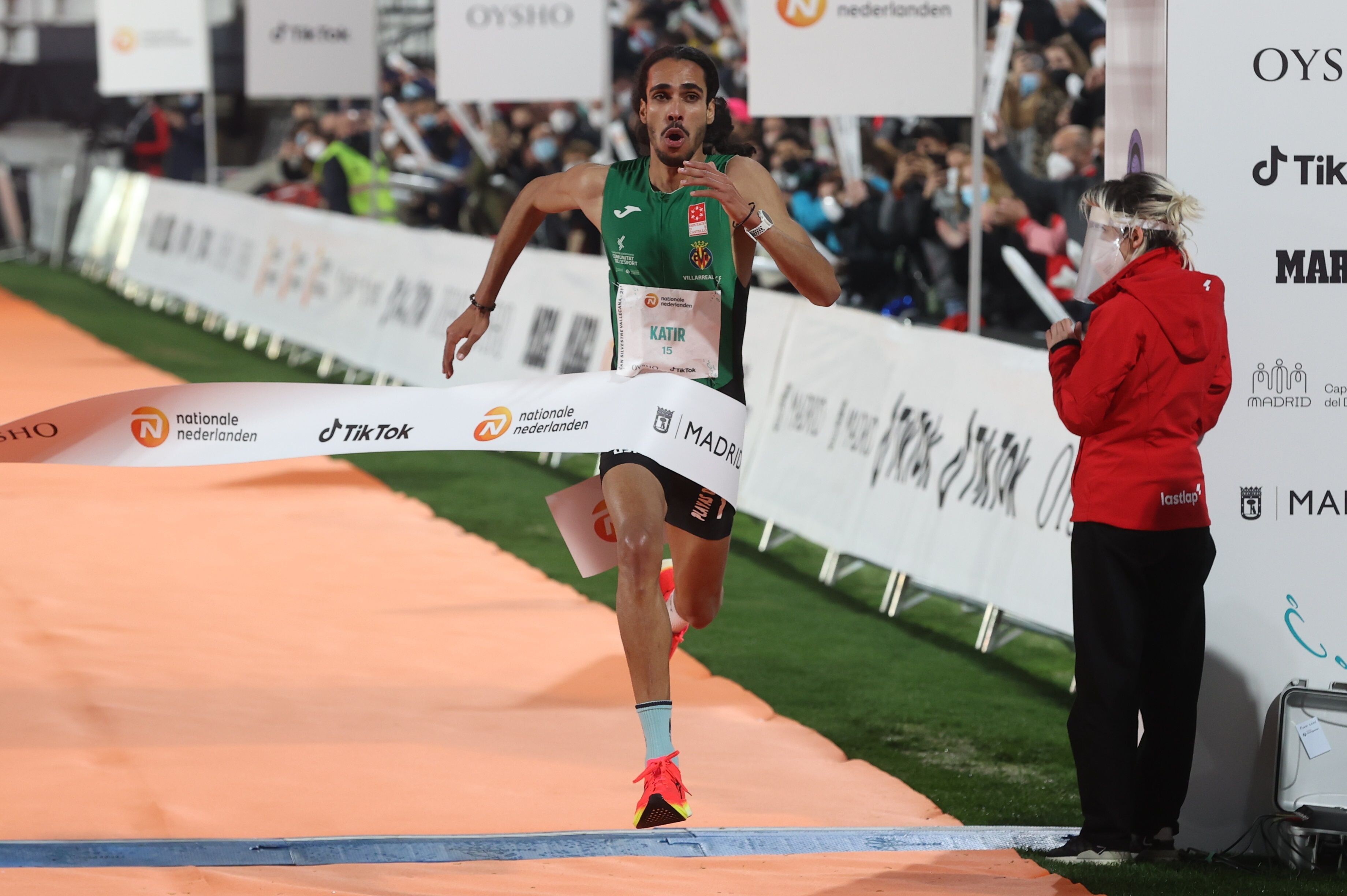
Two-time world 5000m champion Hellen Obiri had been due to compete but she tested positive for Covid-19 and had to pull out on the eve of the race.
The women’s race started at a swift pace, the first kilometre being covered in 2:54 by Azimeraw, her fellow Ethiopian Haven Hailu and Kenya’s Edinah Jebitok. Israel’s Lonah Salpeter and Ethiopia’s Ayel Likina were a few strides behind, covering the first kilometre in 3:00.
The pace proved to be too quick for Hailu who lost ground before the third kilometre, covered in 8:46 by the lead group. Azemiraw and Jebitok went through the halfway point in 14:38, the quickest ever split and well on schedule to break the tough course record of 29:54. By then, Haven ran in third 13 seconds behind, Salpeter clocked 15:04 for Likina’s 15:11.
Azimeraw kept pushing hard over the following kilometres, possibly fearful of Jebitok’s finish, but she finally managed to leave the Kenyan behind just before the eighth kilometre at the beginning of the hardest section of the race.
Azimeraw’s cadence dropped significantly in the closing kilometres, missing her chance of breaking 30 minutes, but she still won comfortably in 30:26. Jebitok, recent winner at the Venta de Baños cross country meeting, was second in 30:44 in what was her first ever road race. Further back, the experienced Salpeter finished third in 31:14.
In contrast to the women’s race, the opening downhill kilometre in the men’s contest was covered in a relatively modest 2:46. It soon became clear that Burundi’s Rodrigue Kwizera, the current leader in the World Athletics Cross Country Tour, had no plans to be a front-runner. Instead, Spanish sub-2:09 marathon runners Daniel Mateo and Yago Rojo were the early leaders.
The lead pack continued at a steady 2:45/2:46 kilometre pace to reach 3km in 8:17 and halfway in 13:46. By then the lead group was still large and led by 40-year-old Spaniard Ayad Lamdassem.
Katir progressively moved to the front and shortly after the seventh kilometre (19:17) made a first serious attack which could be matched only by Kwizera while Kenya’s Shadrack Koech and Spain’s Nassim Hassaous began their own battle for third place.
Once at the uphill section of the race, Katir took command and gradually opened up a gap over Kwizera. By the time Katir crossed the line in 27:45, he had built a 10-second advantage over Kwizera, who in turn was 10 seconds ahead of Hassaous.
“It’s great to win such a prestigious race but I’m not at my peak yet,” said Katir, the Spanish record-holder at 1500m, 3000m and 5000m. “I’m now loading mileage and hope to be in top form in February when I would like to take part in several World Indoor Tour meets.”
(01/02/22) Views: 75
Tokyo Olympic silver medalist Kendra Harrison will headline Millrose Games hurdles field
Kendra Harrison, the world 100m hurdles record-holder and Tokyo Olympic silver medallist, will form part of a stellar women’s 60m hurdles field at the Millrose Games.
The defending Millrose Games champion, Harrison set the current 100m hurdles world record of 12.20 in July 2016. It was indoors that she won her first global gold medal, running 7.70 to equal the US record at the 2018 World Indoor Championships.

In addition to her silver medal claimed in Tokyo, Harrison also earned silver at the 2019 World Championships.
“I had such a great time competing at Millrose in 2020,” Harrison said. “I am looking forward to defending my title in 2022.”
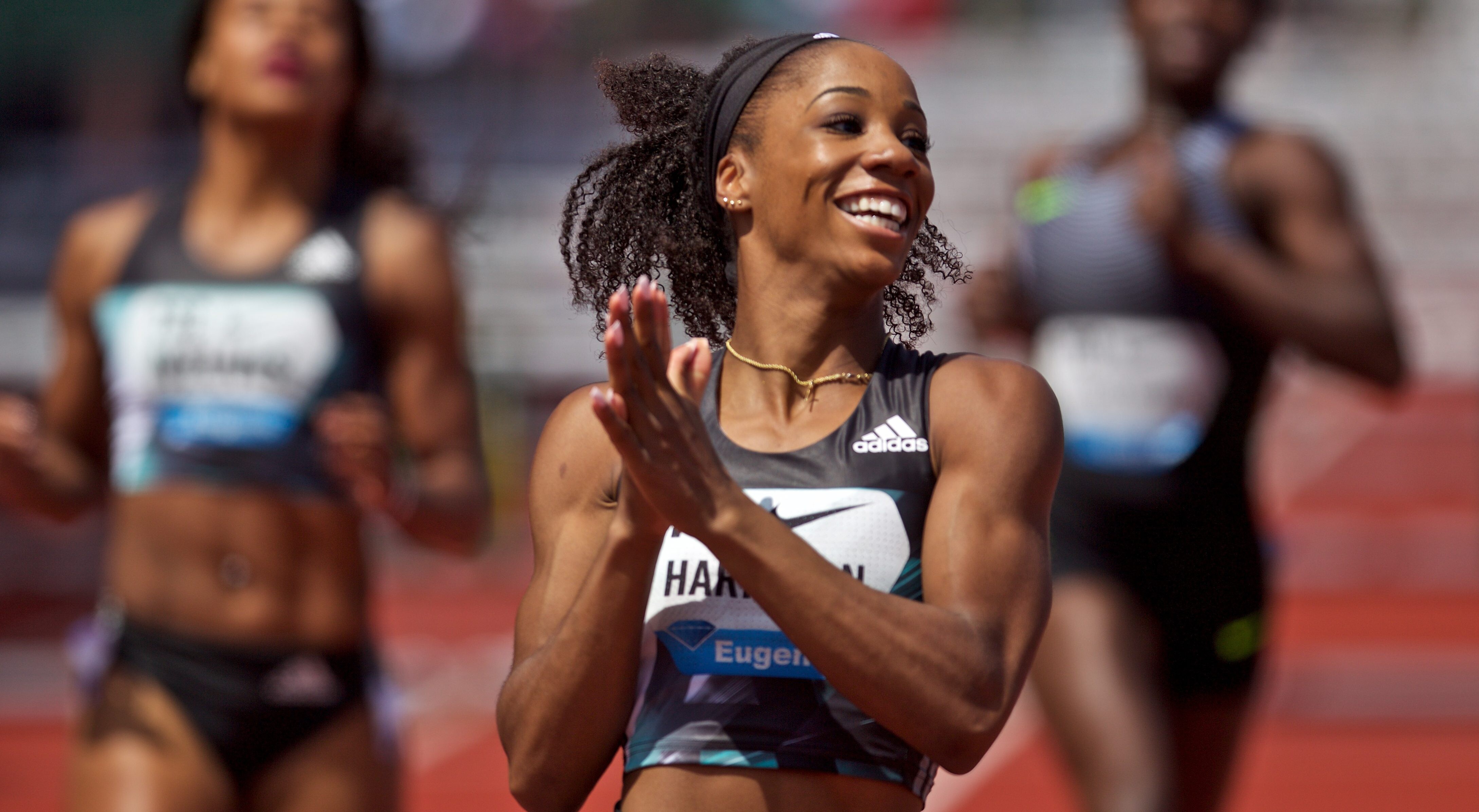
Harrison will be one of six Olympians in the Millrose Games women’s 60m hurdles, with the field featuring three other Olympic finalists from Tokyo.
They include Jamaica’s Britany Anderson, who placed eighth in the Olympic final, plus Devynne Charlton of the Bahamas, who finished sixth, and the USA's Gabbi Cunningham, the seventh-place finisher in Tokyo.
Rounding out this top field will be 2021 NCAA champion and US Olympian Anna Cockrell and Irish Olympian Sarah Lavin.
Other athletes so far announced for the Millrose Games include 2016 world indoor 60m champion Trayvon Bromell, Olympic shot put champion Ryan Crouser, world shot put champion Joe Kovacs, Olympic 800m champion Athing Mu, Olympic pole vault champion Katie Nageotte and world indoor pole vault champion Sandi Morris.
(01/04/22) Views: 71World Athletics
Taye and Aregawi break world 5km records in Barcelona
Ethiopia’s Ejegayehu Taye and Berihu Aregawi broke the world 5km records* at the Cursa dels Nassos in Barcelona on Friday (31), clocking 14:19 and 12:49 respectively.
Taye, 21, had set an Ethiopian 3000m record of 8:19.52 earlier this year, and was the second-fastest woman in the world over 5000m this season, but tonight in Barcelona she was contesting just the second international road race of her career.
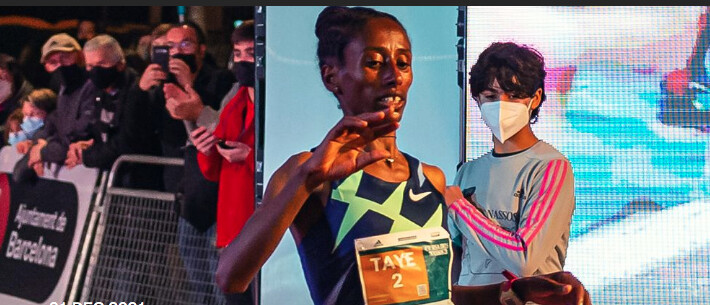
Twenty-year-old Aregawi, meanwhile, had come within one second of Joshua Cheptegei’s world record in Lille last month, so was keen to take another crack at the mark before the year was out to ensure he could end 2021 on a high.
With the women and men starting at the same time, Taye was able to use some of the men in the field as pacemakers. She opened up a clear gap on Sweden’s Meraf Bahta in the early stages and went on to win in 14:19, taking 24 seconds off the world record for the 5km in a mixed race. Bahta was second in 15:04.
Aregawi had a pacemaker for company for the first kilometre or so, but after then was out on his own. The Diamond League 5000m champion stormed through the finish line in 12:49, taking two seconds off Cheptegei’s world record. Peter Maru was a distant runner-up in 13:30.
(01/01/22) Views: 63
World Athletics
Aoyama Gakuin University breaks on course record for sixth Hakone Ekiden win
Riding the momentum of its Hakone Ekiden Day One win, Aoyama Gakuin University broke the Day Two and overall course records to take its sixth Hakone title in eight years.
With all sixteen men on his entry roster having broken 29 minutes for 10000 m and even leaving some recent 62-minute half marathoners off, head coach Susumu Hara had plenty of material to work with on the five-stage 109.6 km Day Two return trip from the mountain town of Hakone to central Tokyo. Handling the 20.8 km descent on the day's first leg, 4th-year Yuki Takahashi was the weakest link in the Day Two lineup in terms of finishing time on his individual stage, running only 8th-fastest, but even so he added a valuable 41 seconds to AGU's initial lead of 2:37.
And from there it was a total blowout. Hironori Kishimoto was the only runner to break 63 minutes on the 21.3 km 7th leg, taking the lead to 4:51. Issei Sato lost 19 seconds to Juntendo University's Masaki Tsuda but was still 2nd-fastest on the 21.4 km 8th leg. Yuito Nakamura blew the race apart with a 1:07:15 course record on the 23.1 km 9th leg, 46 seconds off the old record dating back to 2008 and putting AGU ahead of Juntendo by 7:56. Anchor Hironobu Takakura backed that up with a 1:07:50 course record on the 23.0 km 10th leg, 50 seconds under the old record.

AGU broke the Day Two record in 5:21:36 and took almost 2 minutes off its own record for the full 10-stage, 217.1 km course, finishing 10:51 ahead of 2nd in 10:43:42 with the biggest margin of victory since 1988. That works out to 2:57.9/km including the two mountain stages. How dominant is that? The same pace for 100.0 km, the distance run at Jan. 1 at the 7-stage New Year Ekiden corporate men's national championships, would give AGU a time of 4:56:30. That would have put them in 12th out of 37 teams, not evening taking into account that they were running more than twice as far as the corporate leaguers, only one stage at the New Year Ekiden is as long as what every runner at Hakone does, or that Hakone includes two stages with elevation changes of 837 m. Take those into account and AGU's best 7 could probably be giving New Year winner Honda, who averaged 2:54.6, a run for it, even without a Kenyan. Coach Hara might get it wrong every now and then, but at this point his development program is pretty close to untouchable at the collegiate level.
Behind AGU, the overall race was as complex as expected given how close most of the teams were in ability, way too much to recap. From 2nd to 13th, almost every team changed position on almost every stage. There were as many brilliant days in the sun as devastating setbacks, as many as you could hope for. 2020 Yosenakai qualifier winner Juntendo continued its forward movement after a slow start on Day One, moving from 5th to 3rd thanks to a stage best from downhill runner Keito Makise, then 2nd after another stage best from 8th man Tsuda. Tsuda, a second-string senior, delivered one of the biggest runs of the day, taking out Komazawa's #2 man Mebuki Suzuki to put Juntendo into 2nd, where they stayed. Komazawa fell to 6th as Suzuki faltered, but fought back to 3rd.
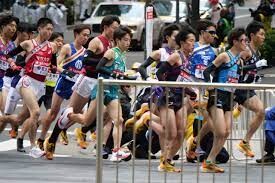
Last year's 3rd-placer Toyo University struggled to stay in the top 10, then caught Komazawa for 3rd in the anchor stage home straight before dropping to 4th in the final sprint. 2021 Izumo Ekiden winner Tokyo Kokusai University bounced between 7th and 4th before landing in 5th. Yosenkai runner-up Chuo University made it as high as 3rd on the 8th leg before falling back to 6th, its first time in the top 10 in ten years. Last year's Hakone runner-up Soka University went from 8th to 5th to 9th to 7th. Koku Gakuin University dropped from 4th to 10th over the first three stages of the day. A stellar run from first-year Kiyoto Hirabayashi took them back to 5th on the 9th leg, but anchor Ryomei Aizawa dropped again to 8th. Teikyo University started in 2nd after an uphill win at the end of Day One by Shoma Hosoya but spent Day Two sweating it out as they fell back as far as 10th on the 9th leg before anchor Shoma Nishiwaki took them back to 9th.
A top 10 placing in Hakone gets you a return trip the next year and an invitation to October's season-opening Izumo Ekiden. 2019 Hakone winner Tokai University clawed its way up to 10th on the Day One 5th leg, then to 8th over the first four stages of Day Two. But anchor Yuta Yoshitomi ran into trouble and dropped, and coming off Nihonbashi with 1 km to go he was caught by Hosei University's Yuki Kawakami. It's a sign of how much trouble Yoshitomi was in that he ultimately finished 52 seconds behind Kawakami, sending Tokai back to the Yosenkai with Hosei getting into the top 10 for the first time in 3 years. Waseda University, Japan's University of Oregon, looked like they might break into the top 10 with good 7th and 8th leg runs from Soshi Suzuki and Ryunosuke Chigira, but they couldn't quite close it up and were caught just before the finish by Kanagawa University.
Even further back there was just as much action throughout the day. The Kanto Region Select Team recorded its best-ever time, finishing 14th overall but not counting in team scoring. 2021 Yosenkai winner Meiji University fought back from a disastrous Day One to overtake top 10 contender Kokushikan University for 14th. Chuo Gakuin University overcame a Day One time handicap to beat Yamanashi Gakuin University and Nittai University for 16th. The debuting Surugadai University, last on Day One, likewise outran its handicap to knock Senshu University down to 20th.
Altogether it was a truly great edition of the world's greatest race, one with more plot lines happening simultaneously than even the ultra-competent Nippon Television production team knew what to do with. That's a direct product of the constantly increasing level of collegiate men's distance running in Japan. AGU and coach Hara may be showing what's possible, but with so many teams raising the average ceiling at once it created the right conditions for tense and exciting racing throughout all 11 hours of action over Hakone's two days. That's good for the athletes, good for the broadcaster and their sponsors, and good for the fans. Japan is losing elite-level races at a rate that should be ringing some alarm bells, but in the lead-up to Hakone's 100th running in 2024 it was a reassuring sign that this one, at least, is only getting better.
(01/04/22) Views: 63Brett Larner
Ingebrigtsen Intervals
The training philosophy underpinning Team Ingebrigtsen is unpicked by Matt Long after witnessing first hand the young Jakob’s domination in Dublin.
It’s the eve of the last December’s European cross country championships in Dublin. Gjert Ingebrigtsen sat down with sports commentator Jann Post for a podcast entitled ‘I det lange løp’ (‘In the long run’). What he had to say has important implications for our understanding of interval training.
Intensity
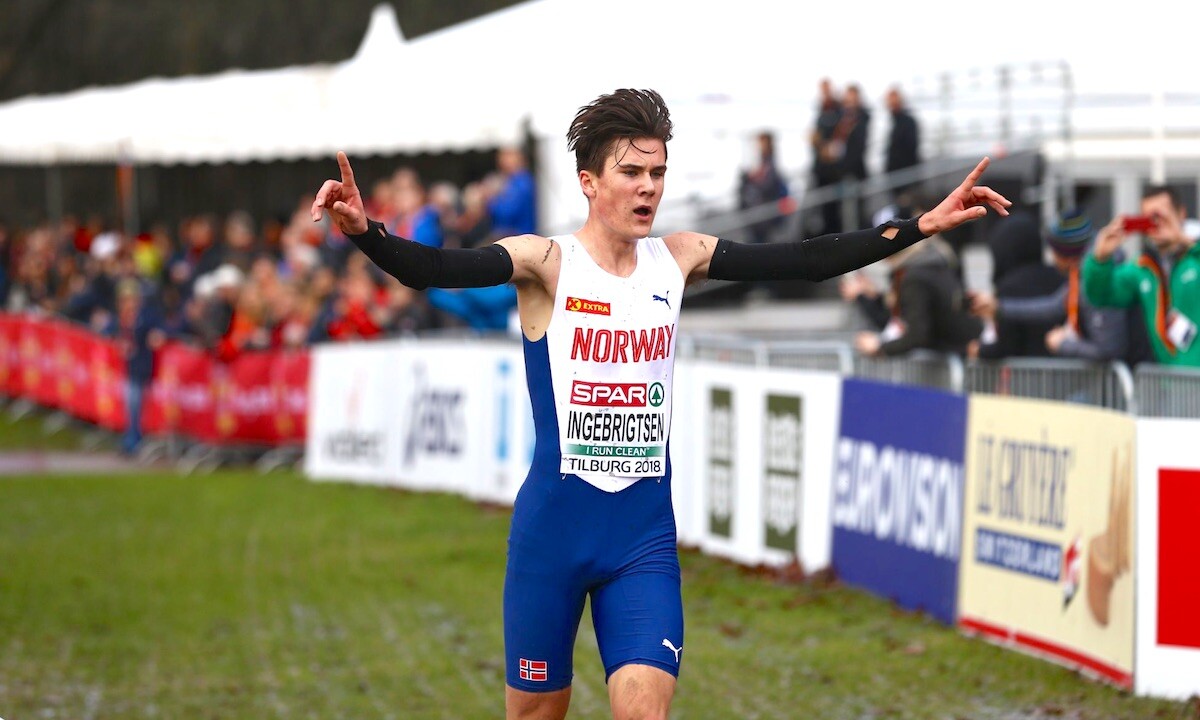
The coach of the terrific trio of Henrik, Filip and Jakob went on record as saying that, “I’m not that concerned if the intensity is too low, that’s more a discussion about speed, but you should definitely not have too high intensity in training because it affects the road forward and we have to make adjustments depending on recovery”.
Typical sessions undertaken by the three bothers have reportedly included 5 x 6 mins at threshold pace; 10 x 1km at threshold pace and 20 x 400m with 30s recovery.
Influence of Igloi
The above approach intuitively borrows from that of the great Hungarian Mihaly Igloi, who famously guided the American Bob Schul to the 5000m gold medal at the 1964 Tokyo Olympics.
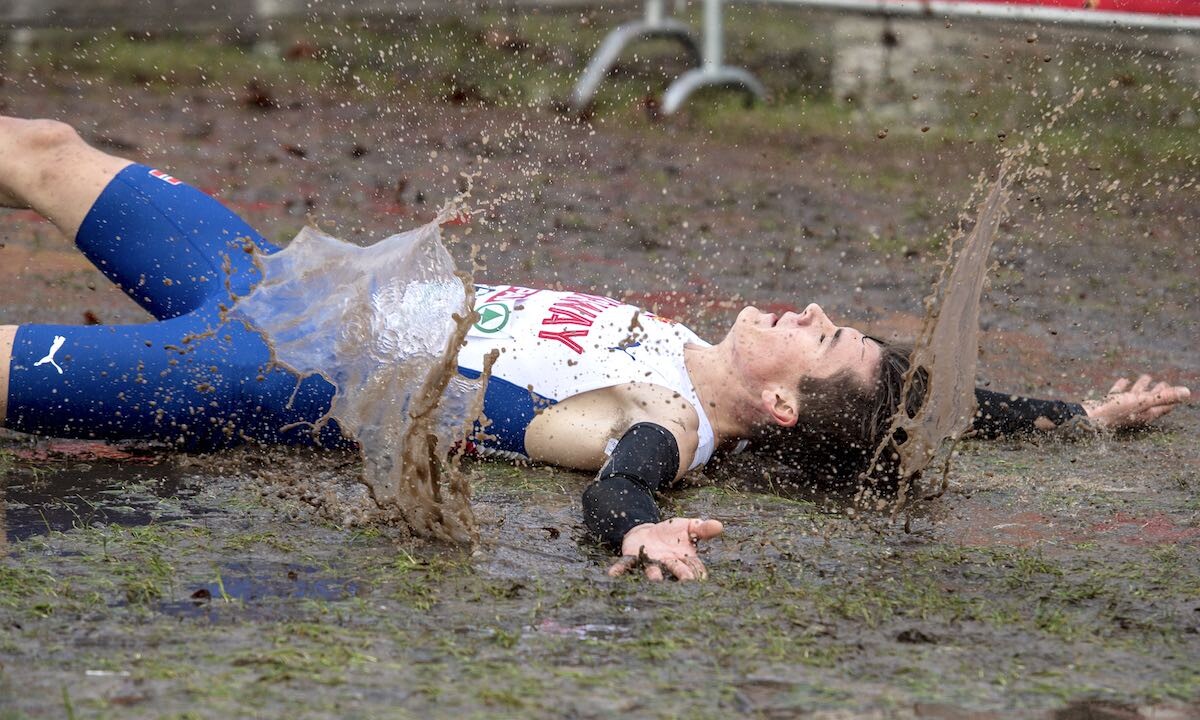
Igloi’s philosophy can be reconciled with that of another great coach. Arthur Lydiard, who espoused the dangers of over working the lactate energy system at inappropriate points of the periodisation cycle thus risking staleness, loss of form and ultimately injury.
The approach of Igloi was to group a relatively high volume of efforts into sets and to effect active modes of recovery during the recovery intervals.
The lactate shuttle
In the mid 1980s the physiologist G.A Brooks coined the term ‘lactate shuttle’.
This notion was used by Oregon based Peter Thompson to espouse the benefits of what he termed ‘lactate dynamics training’, for the mobilisation and clearance of lactate so that it could be utilised around the body as a productive energy source.
The above is inherent in the approach taken by Ingebrigtsen senior. The Norwegian coach recently explained that, “In the area we manoeuvre there’s always injury risk. We are willing to take risk, lots of risk, but we need to ensure that our training, in total, is sustainable so that the boys are able to have a livelihood from running over time.
Some athletes can run insanely fast with low lactate, but that isn’t always purposeful because you can’t directly translate that into winning races. Then it’s about finding the ‘good enough’-limit”.
The above doesn’t of course mean that the Ingebrigtsens don’t do some seriously hard speed endurance work in the Specific Preparation and Pre-competition phases of the training macrocycle especially.
It does however mean that when they are focused primarily on aerobic base building and strength endurance during the winter months they are likely to back off this type of work significantly.
Easy Interval Method
The sentiments expressed above by Ingebrigtsen have a far more modern application than the coaching practice of the aforementioned Igloi.
Klaas Lok’s ‘Easy Interval Method’ was successful in highlighting how, “fairly light exposure to highly anaerobic stresses proved a tremendously effective balance of stimulus’.
Himself indebted to the likes of Hermen Verheul and Woldemar Gerschler, Lok has argued that too much steady state aerobic running lacks the preservation of ‘reactivity’. Runners are effectively operating too slowly in bio-mechanical terms and they tend to be reinforcing incorrect motor patterns.
As well as warning of the dangers of too much one paced aerobic running on the one hand, Lok advocates the need to avoid too many intense interval sessions at or around V02 max, on the other. The Dutchman maintains that the Easy Interval Method allows the athlete to run at a range of aerobically dominant speeds by varying the tempo and adopting a multi-paced ethos, without the acidification of the muscles occurring.
Are you going too fast?
The above is something which sits well with the philosophy of Gjert Ingebrigtsen, who has observed that, “I see people running overspeed in training, and I ask ‘Why are you doing this?’ and I get different answers.
Some say ‘because we can’, others say ‘because we think the athlete is capable of running faster than he has done in races so far’. ‘We think the athlete is capable of XX:XX’ is an answer I get often, especially in Norway for some reason.
They have a 1500m PB of 3:55 and then they run intervals as if they’re a 3:45 athlete, and I ask ‘Why are you doing this?’ to which they reply ‘Because I think I’m capable of 3:45.00’ – but they’re not, they’re still 3:55 runners and they don’t understand. That’s how it goes”.
The above leaves us with some questions for self-reflection:
At what point of the periodisation cycle do I need to be undertaking repetition training using fast efforts with passive recoveries, in order to stimulate my lactate energy system?
How might the use of intervals with an active mode of recovery help me control the intensity of the efforts being undertaken, thus keeping my work aerobically dominant during the aerobic and strength endurance phases of my training macrocycle?
Why should I be aware that there is a difference between a simple jog recovery in interval training and a more active ‘roll on’ recovery and how might the latter facilitate the lactate shuttle more effectively?
In what ways might the adoption of the kind of approach taken by the Ingebrigtsens help me to avoid injury and aid my long term development and retention within our sport?
Matt Long has served as both an England Team Manager and Coach and welcomes contact for coaching support at mattlongcoach@gmail.com
(12/31/21) Views: 61Top athletes for Memorial Agnes Tirop World Cross Country Tour
Three-time world half marathon champion Geoffrey Kamworor has confirmed his participation to the Memorial Agnes Tirop World Cross Country Tour on February 12 in Eldoret, Uasin Gishu County.
Kamworor said during the launch of the race at Lobo village in Kapseret Tuesday that he will be happy to compete with other international athletes in honoring the departed Tirop.
“It was so sad to loose such hard working athletes and competing in the race next month will give me joy because she was my best friend in cross country. We used to encourage one another before the race and since she is no more, I have to compete and run well,” said Kamworor.
Ethiopia’s Letesenbet Gidey the 5,000m, 10,000m and half marathon world record holder, will also line up in the women’s 10km race.
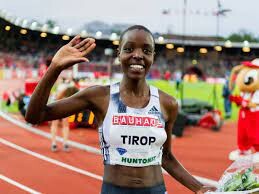
Forty invited athletes will grace the race with many Kenyan athletes expected to join the list once they are selected after the national trials which shall be held at the same venue in Eldoret.
Some of the races that will be taking place include 10km senior men and women, 8km junior men, 6km junior women, Under-18 6km boys, Under-18 4km girls, 2km boys and 1km for children and masters race.
Athletics Kenya President Jack Tuwei said the race is the only one in Africa and the last one in a series of 17, adding that Eldoret was picked by World Athletics as one of its venues for the inaugural 2022 World Cross Country Tour.
World Athletics introduced cross country tours races which will be subsequently categorized as gold, silver or bronze and will come with additional prize monies for the best performers.
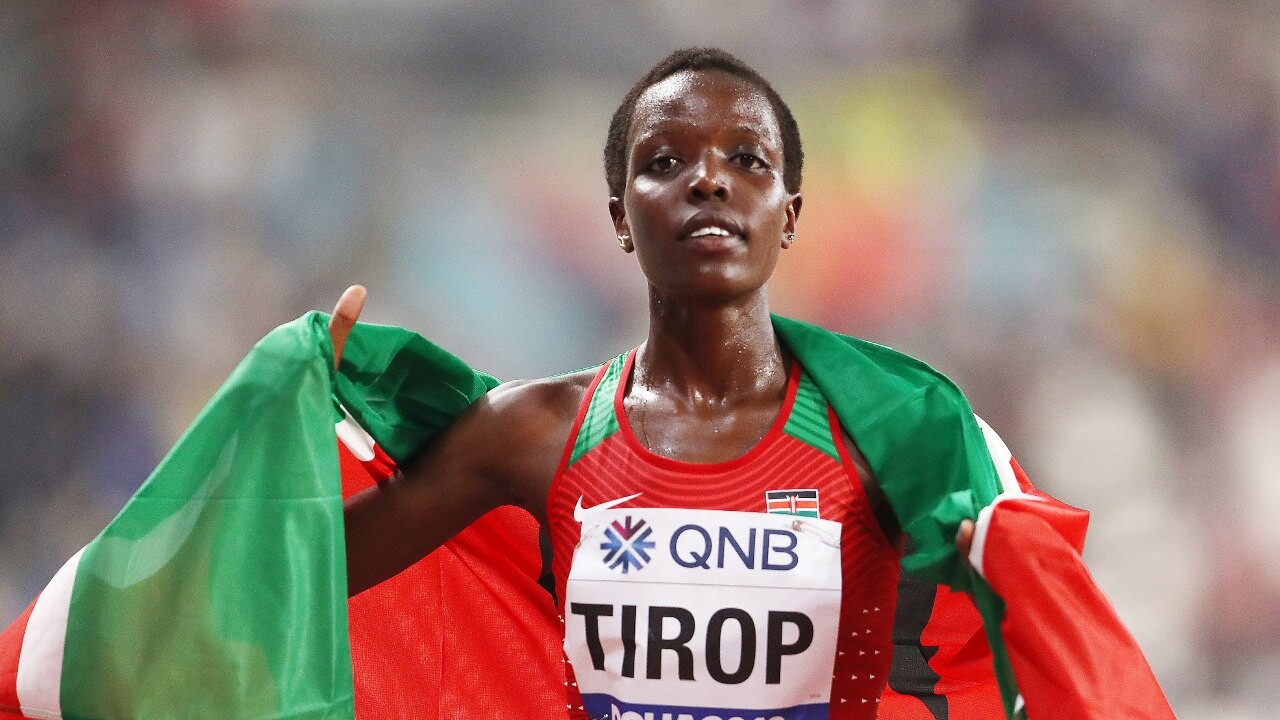
Out of the $400,000 (Sh43m) prize money for the best performers, $75,000 (Sh8m) will be set aside for the best male and female runners in the cross country tour.
“We decided to name the race after our hero Agnes Tirop who was murdered last year as one way of honoring her. The Local Organizing Committee is on top of things and we shall be able to deliver a world class event," said Tuwei.
Sports Cabinet Secretary Amina Mohamed warned rogue coaches and agents who want to ruin the sport by fleecing athletes of their hard earned cash or introducing them to drugs.
“It is really sad we are mourning the champion today who was to compete in the race because of rogue people surrounding her career. Going forward we shall be able to vet those handling athletes because the report that I will be releasing next week has a lot of issues which have to be addressed immediately,” said Amina.
She further said that Kenya has shown the world her prowess in the sport and athletes should continue working hard and carry the country’s flag high in the forthcoming events.
(01/04/22) Views: 59Bernard Rotich


